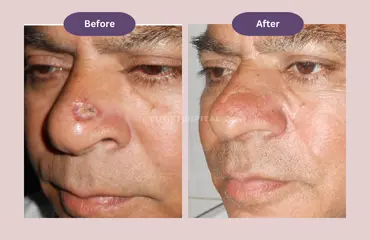Skin cancer surgery is performed for tumors that have not spread, and usually no other treatment is required. However, if doctors suspect aggressive tumors (melanoma) extensive surgery is required – the affected organ is removed to prevent further spreading. The range of skin cancer treatment includes surgical procedures, biopsies, and wide excisions. Other types of treatment administered includes radiation therapy, Photodynamic therapy, and Chemotherapy. Depending on the size of tumor, the surgery is conducted under local or general anesthesia at the doctor’s clinic or in a hospital.
Mohs surgery: Designed by Dr. Frederick Mohs in 1930, this procedure removes tumors from the skin layers while preserving maximum healthy tissues. This surgery is actively used on visible areas like neck, hands, and head to reduce scarring. It requires a local anesthesia.
Excision: Scalpel is used to shave or cut the cancer growth on the skin. Local anesthesia is administered to the patient. The surgeon can perform from any of the three types of skin cancer surgery - simple excision, shave excision, and wide excision.
Other surgeries include Curettage and electrodesiccation, Reconstructive surgery, Laser surgery, Cryosurgery, and Lymph node biopsy and removal
Depending on the size, depth, and location of the tumor, the skin cancer treatment varies. Treatments include wide excisions, biopsies, plastic surgery, and Mohs surgery. Other extensive treatments include photodynamic therapy, chemotherapy, radiation therapy, freezing, and biological therapy. These procedures are used to treat precancerous skin lesions and basal cell cancers. Small lesions present on the skin’s surface only require biopsy to remove them completely.
For low-risk skin cancer, the surgeon uses local anesthetic to numb the area before operating on the tumor. Once the tumor is extracted, the healthy skin is stitched back. Usually, the surgery leaves scar of the incision. Some patients post the surgery can return home the same day while others need to convalesce in the hospital.
Complications emerging from skin cancer surgery include:
Doctors from different specializations work in teams to provide you with complete care. Our team has several years of experience in the diagnosis and treatment of all skin cancer types.
Further, we have a fully equipped research & development lab that offers you the opportunity to participate in clinical trials for the latest treatments and procedures. Our department is created in strict compliance with National Cancer Institute standards. Hence, the safety of your health is in good hands.



A surgical excision of lesions has a better cure rate as compared to other treatments. Also, the procedure is faster than other skin cancer treatments.
Based on the stage and type of cancer and your health, your doctor will advise the best treatment plan. For low-risk cancer, surgical excision is done. Your doctor will numb the affected area with local anesthesia before removing the tumor. The healthy skin surrounding the area is stitched back, leaving a scar on the surgical incision.
The sample will be sent to a laboratory for examination if the growth is suspected to be cancerous. Once the surgery is done, you must keep the excision area dry for 24 hours, apply the prescribed medication to the area for faster healing, avoid sunlight, and take painkillers if needed.
The operated area can be inflamed and red for a month, but if you experience severe pain or an infection, immediately call your doctor.
Patients with low-risk cancer growth are advised to undergo a surgical excision.
If your skin biopsy suggests that you have melanoma, this procedure is effective in removing the complete tumor. Also, if you suffer from low-risk basal cells, you can opt for this surgery.
The doctor will examine your skin for changes that appear to be cancerous, and pathological test reports will confirm the prognosis.
Cutis Hospital is conveniently located in Ghatlodia, Ahmedabad, making it easily accessible via multiple modes of transportation. Below are the various ways you can reach our facility:
Sardar Vallabhbhai Patel International Airport: Located approximately 12.7 km from Cutis Hospital, offering convenient access for patients traveling from outside the city.
Chandlodiya Railway Station: Approximately 2.4 km from Cutis Hospital.
Ahmedabad Railway Station: Around 11 km from our center.
GSRTC:
Ahmedabad Central Bus Station (GSRTC): About 10.3 km from the hospital.
AMTS:
Bhuyangdev Cross Road Bus Stop: Just 500 meters from Cutis Hospital.
BRTS:
Bhuyangdev BRTS Bus Stop: Only 170 meters from our center.
We provide effective surgical and non-surgical treatments for all parts of the body. At Cutis Hospital, our cosmetic and plastic surgery team is committed to giving patients safe and high-quality care.